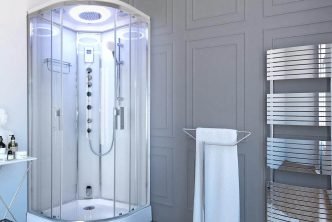The unassuming door pane, often overlooked, plays a surprisingly pivotal role in the aesthetic and functionality of your home’s entrance. In a world obsessed with black accents and modern elegance, black door panes have become a popular choice, offering a touch of sophistication and drama. But with a myriad of glass options available, the journey to finding the perfect pane can feel like an odyssey through a labyrinth of choices. Fear not, fellow design adventurer! This guide will equip you with the knowledge to navigate the world of black door panes and select the one that unlocks the door to your dream entryway.
Table of Contents
The Power of Transparency: Crystal Clear Glass
For the minimalist at heart, crystal clear glass panes offer an undeniable allure. They allow for maximum natural light to flood your entryway, creating a bright and airy atmosphere. This is particularly beneficial for smaller spaces or homes with limited access to natural light. Additionally, clear glass panes provide an unobstructed view of your porch or entryway, enhancing your home’s curb appeal and fostering a sense of connection with the outdoors. However, keep in mind that clear glass offers little privacy, making it less suitable for entryways directly facing the street or close to neighboring houses.
A Touch of Mystery: Reeded Glass
For those seeking a touch of intrigue and privacy, reeded glass emerges as a captivating option. The beautiful vertical lines etched into the glass create a mesmerizing texture that partially obscures the view while allowing light to filter through. This provides a desirable level of privacy without sacrificing natural illumination. Reeded glass panes come in a variety of patterns, from classic to contemporary, allowing you to match the style of your home. Remember, the thicker the reeds, the more privacy they offer, but also the less light they transmit.
The Textured Allure: Seeded Glass
Seeded glass, also known as “antique” glass, offers a unique aesthetic with its subtle, organic imperfections. The tiny air bubbles trapped within the glass create a textured effect that adds depth and character to your entryway. Similar to reeded glass, seeded glass provides some privacy while allowing light to pass through. However, the level of obscurity is generally less than reeded glass, making it a good choice for entryways with ample natural light.
Combining Textures and Styles
For the truly adventurous, the world of black door panes doesn’t end there. Consider combining different glass textures within the same pane to create a unique and visually striking design. For example, you could use clear glass in the upper portion of the pane for maximum light and reeded glass in the lower portion for privacy. You can also explore colored glass options to add a pop of personality to your entryway.
Choosing the Right Fit: Practical Considerations
Before embarking on your glass odyssey, remember to consider some practical factors. Firstly, assess the amount of natural light your entryway receives. If it’s limited, clear glass might be the better choice. Secondly, think about your privacy needs. If you value complete privacy, a solid door might be more suitable. Finally, factor in your budget. Reeded and seeded glass is generally more expensive than clear glass.
Beyond Aesthetics: Decoding the Material Science of Black Doors
Black doors become a coveted design element, gracing modern and traditional homes alike. But delve deeper, and you’ll discover a fascinating interplay of material science and design choices. This article peels back the layers, exploring the technical differences between clear, reeded, and seeded glass – the black door’s enigmatic heart.
The Foundation: Understanding Glass Composition
All three glass types share a basic composition: silica (SiO2), the main ingredient in sand, forms the glass network. This network is strengthened by adding alkali oxides (like sodium or potassium) and alkaline earth oxides (like calcium or magnesium). These oxides modify the glass’s melting point, viscosity, and other properties.
Clear Glass: Simplicity and Purity
Clear glass, also known as float glass, prides itself on its simplicity. Its composition aims for purity, minimizing trace elements that could introduce color or cloudiness. The manufacturing process, float glass production, involves melting a carefully formulated mix of raw materials at high temperatures (around 1500°C). The molten glass is then floated on a molten tin bath, ensuring a smooth, distortion-free surface.
Optical Properties: Clear glass allows maximum light transmission (around 90%), making it ideal for maximizing natural light in your entryway. It offers a true and undistorted view of the outside world, ideal for showcasing your porch or landscaping.
Reeded Glass: A Textural Tapestry
Reeded glass, also known as textured glass or ribbed glass, adds a touch of intrigue and privacy. Its defining feature is the vertical ridges pressed into the molten glass during production. This rolling process can use smooth or patterned rollers, creating various reed widths and depths.
Optical Properties: Reeded glass diffuses light, offering partial privacy while still allowing some light transmission (around 70-80%). The level of obscurity depends on the reed thickness and pattern. For example, narrow, close-set reeds offer more privacy than wider, spaced-out ones.
Seeded Glass: Organic Imperfections
Seeded glass, also known as antique glass or cathedral glass, carries a unique charm with its subtle imperfections. Tiny air bubbles are trapped within the molten glass during its production, creating a textured, slightly cloudy appearance. Two main manufacturing methods achieve this effect: the Fourcault process stretches the molten glass, introducing air bubbles, and the cylinder process blows air bubbles into the molten glass.
Optical Properties: Seeded glass offers moderate privacy with light transmission varying based on the bubble density (around 60-70%). The bubbles scatter light, creating a soft, diffused glow and obscuring the view but maintaining a sense of openness.
Beyond the Basics: Advanced Glass Options
The world of black door panes goes beyond these three main types. For the truly adventurous, explore:
- Low-emissivity (Low-E) glass: coated with a special film to improve energy efficiency by reflecting heat back into the home.
- Laminated glass: two or more glass layers bonded with an interlayer film, offering enhanced security and noise reduction.
- Stained glass: colored glass panels crafted using various techniques, adding a unique artistic touch to your entryway.
Choosing the Right Pane: Balancing Aesthetics and Functionality
With this understanding of the material science behind each glass type, you can make informed decisions for your black door. Consider:
- Privacy needs: Clear glass offers transparency, while reeded and seeded glass provide privacy levels depending on their texture.
- Light transmission: If maximizing natural light is crucial, clear glass is the way to go. For a softer, diffused light, consider reeded or seeded glass.
- Maintenance: Clear glass is easiest to clean, while textured glass might require more effort due to the grooves and bubbles.
- Budget: Clear glass is typically the most affordable, while more intricate textures or specialty options like Low-E glass might cost more.
The Final Chapter: Your Perfect Pane Awaits
With a plethora of options available, choosing the right black door pane can feel overwhelming. But remember, the perfect pane is the one that reflects your personal style and fulfills your functional needs. So, embrace the journey, experiment with different options, and unlock the door to an entryway that reflects your unique personality.
Bonus Tip: Before making your final decision, consider ordering small samples of different glass types to see how they look in your entryway’s lighting conditions.





